

Can you stand to ratchet up the cuteness level even higher? Can your pancreas take all that extra sweetness? Be honest with yourself. You know you can’t resist the power of Kawaii. It’s like hitting the event horizon of a black hole. The cuteness just sucks you in.
Anthros are amazingly cute and superpopular character types in Kawaii. Everyone loves them. A Kawaii-style anthro is a human character in animal costume. Sometimes the costume is minimal; but oftentimes, it’s a full-body animal suit. The focus of most Kawaii anthro costumes is the oversized, cute hood, which is drawn in the shape of an animal head.

The typical anthro hood surrounds the entire head, with an opening for the face. This circular opening emphasizes the roundness, which conveys cuteness. Can’t get too much cuteness. (Some anthro hood variations don’t surround the entire head. We’ll see some of those examples later in this section.)
Notice that there’s even an expression on the hood’s face! And it doesn’t necessarily have to match the expression on the wearer’s face. It can, but it’s also fun to give the animal hood a mind of its own. The oversized hood also has the effect of bumping up the size of the head, which keeps the character looking young.
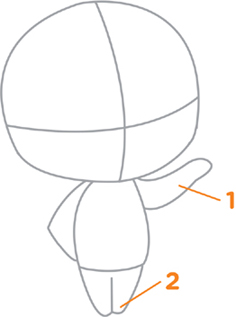
1. Notice how body language indicates impatience.
2. Put legs together, providing a cute, young look.
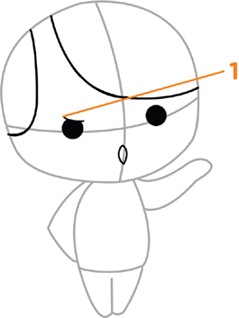
1. Uneven eyebrows are often funnier than even ones.

1. Look how much extra size the hood adds to the head!
2. Hood fits snugly.
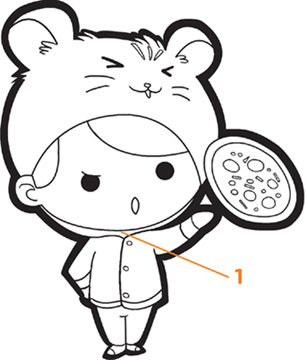
1. Show a tiny bit of material for the “wraparound” of the hood.
When drawing a Kawaii character, don’t try to accomplish too much with the pose. These are cute, chubby, little tykes. Action poses aren’t necessary and can even detract from their almost incomprehensible dearness.
For variety, this time we use a hat instead of a hood! Not only that but the hamster on the hat looks less like a real hamster than the one on Hamster Boy. It’s just as cute and funny, but the design and colors are more whimsical and fanciful. It’s just another approach. You don’t have to be literal in the Kawaii style. Cute is more important than realism!

1. Draw the head so that it looks big in back. This adds appeal to young characters. Weird but true.

1. Use bangs to cover the forhead, but stop just before the eyebrows.
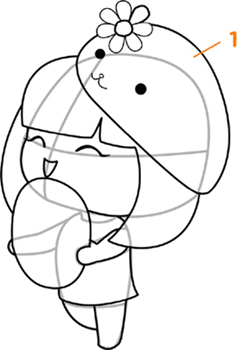
1. Add a stylish tilt to the hat.

1. Notice that the outlines are thick, while the lines inside the figure are thinner. This is another stylistic approach of graphic designers.
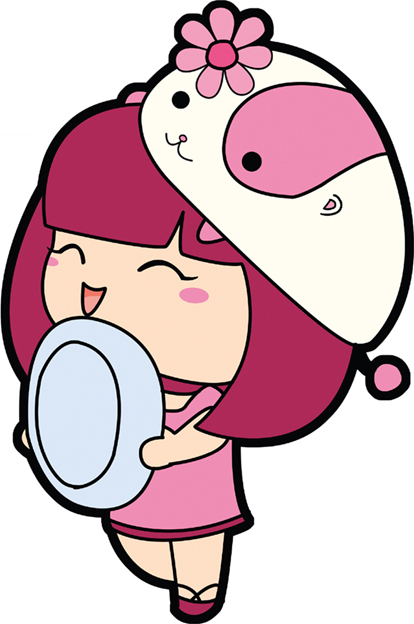
Note the cute accents: The blush marks aren’t soft and subtle but are funny, solid, pink ovals.
Tiger Boy is a good example of a third approach to creating cute anthros. This is a good example of a full head-to-body costume. The hood and bodysuit are part of the same outfit; they never come à la carte. Note that the muzzle of the tiger dips below the hood, breaking the circular outline. This technique makes the hood stand out. The anthro character is often drawn to reflect the personality traits of the human who wears it, in this case producing an aggressive and bossy tiger.
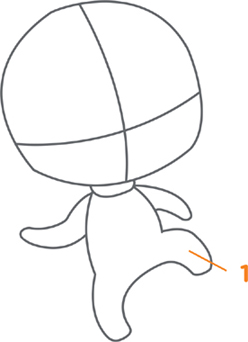
1. Action poses look funny on these supertruncated bodies.
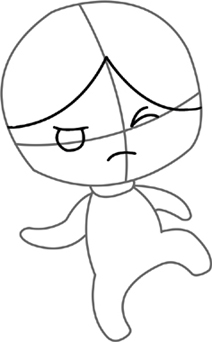
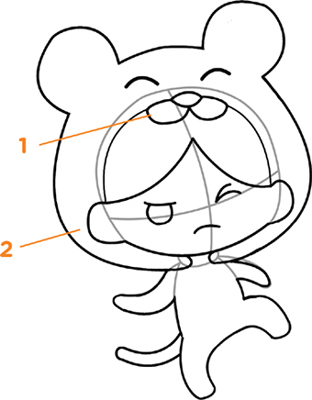
1. Note the two “pads” of the muzzle, which are important features of the tiger’s face.
2. Even though the hood displays tiger ears, draw Kawaii characters with their human ears still intact.
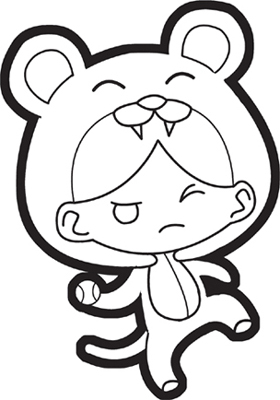
Add stripes so that people know this is a tiger. Orange and black provide a standout color combination that commands attention.
The pinks, reds, and grays of this anthro work in a cool pattern. Hats have another advantage over hoods for girl characters. A hood covers the entire head, hiding the hair. A hat allows the hair to unfurl. Look at the funny duality of expressions: She’s having a rockin’ good time, while the kitty is fast asleep on top of her head.
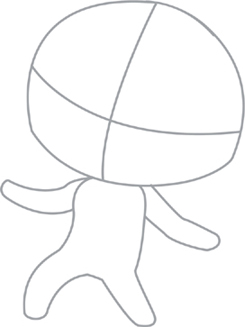
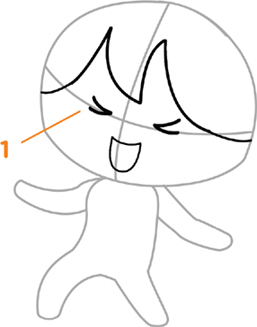
1. Convey a feeling of intense joy by combining closed eyes with an open-mouthed smile.
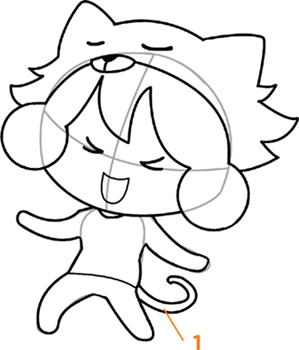
1. Give her a more appealing tail by adding a curl.
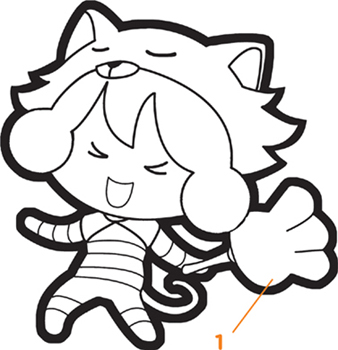
1. When inventing a fun prop, make it relate to the character. Here’s a giant cat’s paw.
You don’t have to use the exact color scheme of a real tiger. If you become adventurous with the costume design, you can also become experimental with the color palette.
Sometimes, a little Kawaii character is drawn to look perfectly normal, even preppy, or sporty and fashionable. There’s only one teeny little thing that’s out of place: He’s wearing a huge animal on his head. Why this works, and how this all got started, few people really know; and those who do aren’t telling. But for these purposes, all you really need to know is that it’s a superpopular look that adds character and charm to regular Kawaii characters.
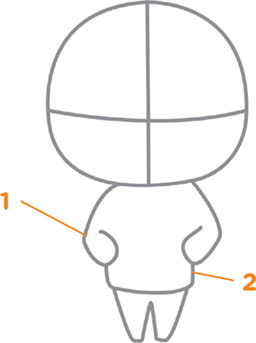
1. Add short and puffy jacket arms.
2. Make the top (jacket) a little wider than the legs (trousers).

1. Brush hair to one side for a casual look.
2. Notice the satisfied smile on his face.

1. The hat adds both height and width.
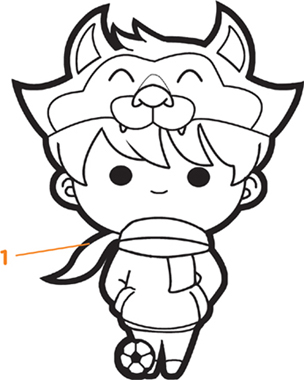
1. The scarf covers part of the chin for a cozy look.
The somewhat muted colors give the reserved little character a sense of cute dignity.
Remember that we said that hoods are often difficult items for female characters, because they hide their long hair? Well, look how inventively that problem was solved here: The pink fur that surrounds her head is ruffled so that the hood actually gives the appearance of hair. And that’s what keeps her looking so feminine.
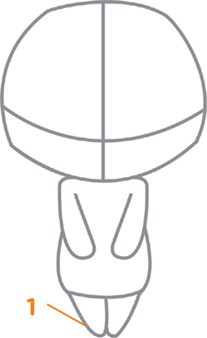
1. Give her a petite stance by tucking arms and legs into the body.

1. Add teeny ears.
2. Tilt eyes upward at the ends, following the natural curve of the eye line.

1. To make the animal’s “face” look as cute as possible, draw its features as low on the hood as you can place them.

1. It’s okay to add some detail to the hood.
Many beginning artists believe that they shouldn’t put different shades of the same colors side by side, because it won’t make for enough contrast. As you can see by this Kawaii girl’s example, contrast should not be the sole deciding factor. Sometimes, using several shades of the same color is a very stylish choice.
Anthro hoods and hats can be based on any animal. But don’t forget the Japanese classic: the panda bear. In addition to its classic cuteness, there’s also an artistic reason the panda works well as an anthro character. The panda’s naturally large and round head maintains its shape, even when transformed into a hood. The black-and-white markings are clear and high-contrast, and instantly telegraph the identity of the animal.
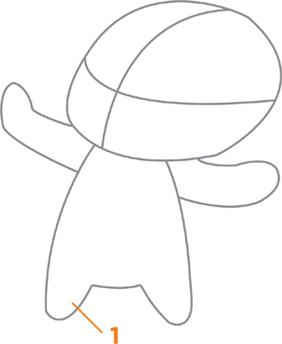
1. Spread the legs apart—give him the posture of a character standing his ground.
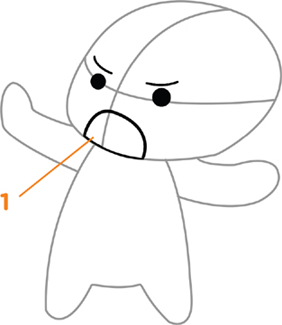
1. Unlike in Western-style comics, draw the mouth so wide that the lower lip vanishes entirely!
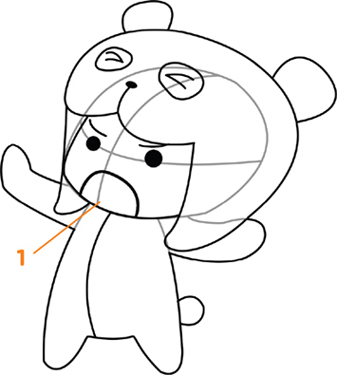
1. By not tying the bottom of the hood you reveal more of the face.
1. Because the panda is monotone, the character looks almost complete in the inked stage!
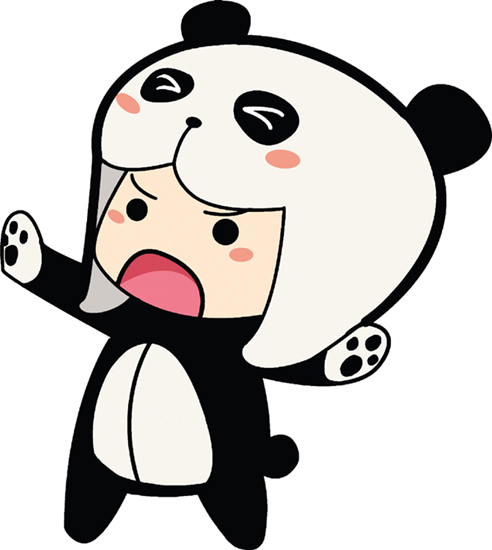
A touch of color used as an accent goes a long way toward giving this little guy added appeal. Adding color is fine, but with such iconic markings as those of a panda, it’s best not to alter the basic pattern and palette.
Most of the time, anthro hats and hoods are worn like clothing—characters don’t acknowledge them or interact with them. But anthro hoods are also used to create humorous situations. One approach is to give your hood personality, a mind of its own. For example, the panda hood could be continually slipping over the boy’s face, as it does here. Or it could be mean, squeezing the boy’s head and not letting go. Maybe it makes fun of the boy, by making goofy faces out of eyeshot when he’s talking. You can easily make up some of your own humorous scenarios. The main element in all these situations is that the hood takes on a life of its own.

1. Draw the hands trying to push the hood off his head.
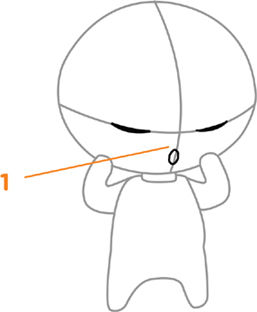
1. Form a surprised expression by using a tiny circle or oval as a mouth.
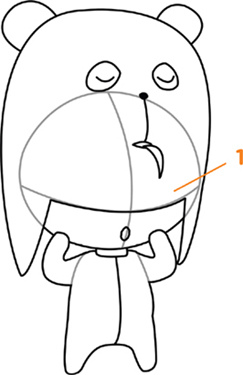
1. Draw this funny hood as a “ginormous” head—so big, it even covers the kid’s eyes!
1. “Checkerboard” the blacks against the whites so that each stands out against the other.
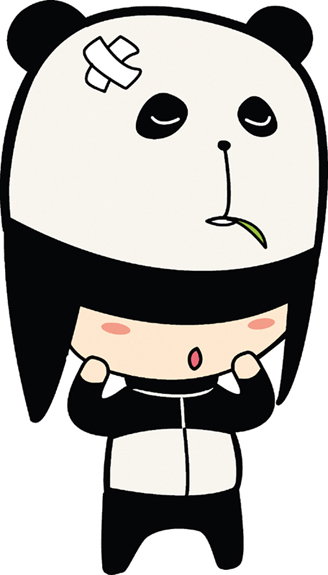
Only a touch of skin color is required for contrast to show that there’s a head stuck under that hood!
Previously, you may not have thought of animal hoods with antlers. Until now, you may not have thought of animal hoods at all. But you’re in the big leagues now.
The key to drawing Kawaii-style antlers is to make them small and rounded, rather than sharp and long. Real deer have angular faces—even baby deer. So how do you maintain the deer’s head shape, while transforming it into a hood? The short answer is, you can’t. It would end up looking boxy, and that’s not cute. Instead, you’ll have to invent a fun and imaginative version of a deer. It’s good that we have those antlers, because they’re an important visual marker—they communicate to the reader that this is, in fact, a deer.

1. Your early construction step doesn’t have to be unique for each character; it simply has to be cute.
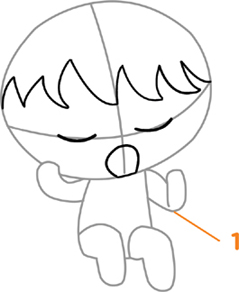
1. Use rounded elbows, instead of hard angles, for a cuter look.
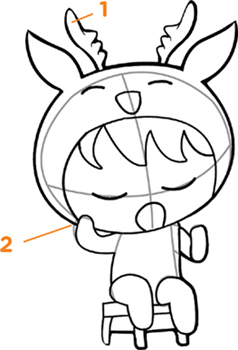
1. Antlers are short but rounded.
2. Opening for head is drawn as a smooth, wide oval.
1. Notice the classic deer-type ears.
2. Both the boy’s face and the deer’s face have their eyes closed—two characters in sync.
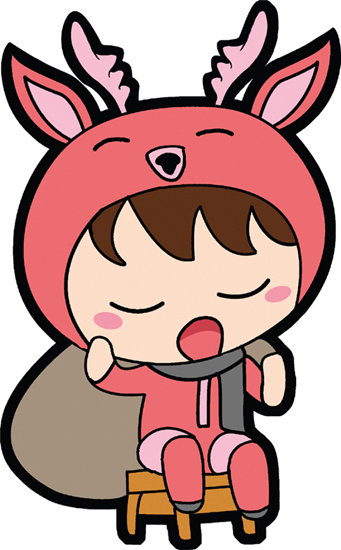
Note that Kawaii expressions can be quite minimal and still retain the character’s personality. For example, this little guy has no eyebrows—and doesn’t need them!
How simplified can an anthro costume be and still be considered an anthro, rather than a cute Kawaii character wearing an adorable little hat? This picture pretty much illustrates that threshold. This deer hat has eyes, nose, ears, and antlers, but they’ve been so minimized that they hardly register. If I hadn’t told you it was a deer, would you have been able to guess? Then again, would it matter? As long as it’s cute—and it is—the character is a winner. The main thing to keep in mind is that an anthro-style hat can’t be small and petite. It has to be sizable, encompassing a large area, and with an obvious animal derivation. The animal ears and horns on this hood fulfill that requirement.

1. Give her a 3/4-length skirt.

1. Draw wavy hair.
2. Attach a couple of eyelashes to her eyes.
3. Mimic animal’s lips with a subtle, split lip.
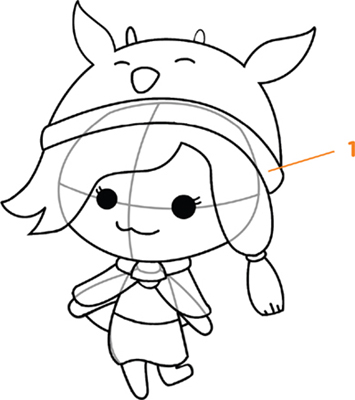
1. Wrap the anthro hat band around the widest part of the head.
1. It’s a funny combo—so dainty but drawn with such thick ink lines!

The hat and cape share the same color. If every color on the figure were different, nothing would tie together, and the image would appear somewhat chaotic.
A cute hood can actually be used as a fashion accessory, just like a purse, shoes, or a scarf. So add a bow, flower, scrunchy, or headband to the hood. Make sure the colors match the outfit. In cases like this, where the hood serves as clothing and not as an alter ego, draw the hood character’s eyes closed to keep its personality subdued.
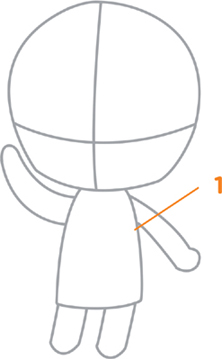
1. Draw the basic body shape first, before sketching the larger jacket over it.
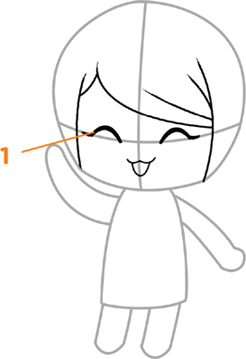
1. Use a bold line for the closed eyelids.

1. Legs curve slightly to the left, rather than going straight up and down, to give the character a bit of movement.
1. Floppy rabbit ears are fun; upright rabbit ears are more realistic.
 QUICK TIP
QUICK TIP
Many different color options go with white. Most people don’t think of it, but white is a very versatile color.
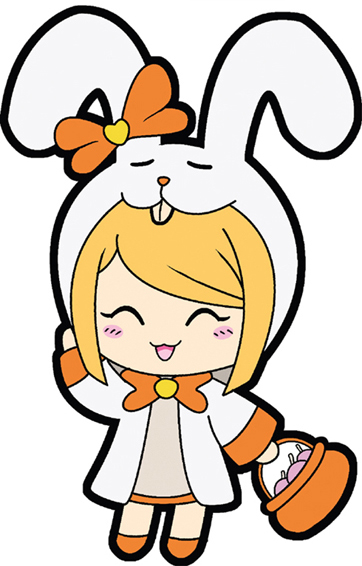
1. No pockets, no buckles, no buttons. But just keeping it simple isn’t enough—your character also has to have the right style.
Here’s an example of a hood that is smaller than the head of the character wearing it. As a result, his hair sticks out on either side of the hood. The hood flaps dangle at the sides of his head, unless you connect them below his chin. Personally, I prefer hoods that surround the entire head. But this technique has a playfully silly look to it, which can add variety to a cast of anthro characters.
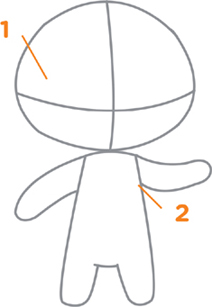
1. Note the oval head shape.
2. Create an interesting pose with one arm up and one down rather than having arms in identical positions.
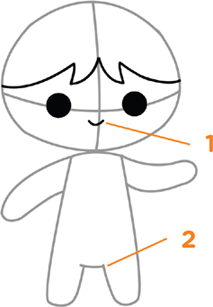
1. Give him a cute, tiny mouth.
2. Construct him with a low center of gravity.
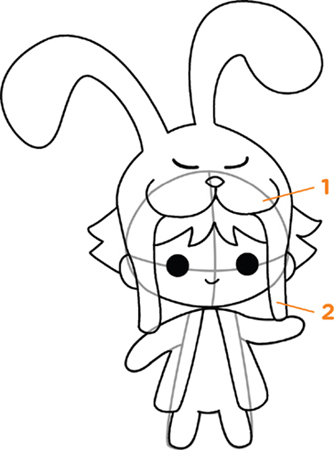
1. You can even give his hood a big, goofy grin!
2. Let hood flaps dangle freely below his head.
1. Add a prop that relates to the character.
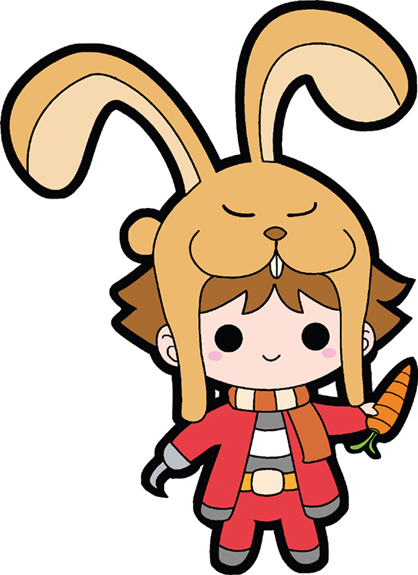
The natural colors for bunnies are white, gray, and brown. The more popular whimsical colors are pink, light blue, and sometimes yellow.
Got a Goth? Then you’ll want to give it a standout icon or accessory to make a splash. Try bat wings. They’re cool and stylish—and they immediately convey darkness.
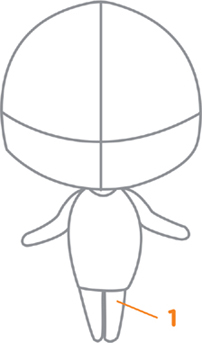
1. Believe it or not, these are actually long legs for a Kawaii character!
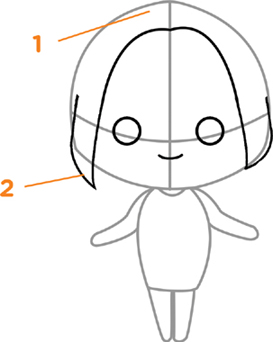
1. Part the hair down the middle, at the center line.
2. Add strands of hair falling in front of the ears.
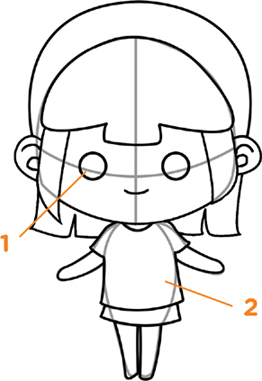
1. Empty eyes are good for an eerie look.
2. At this point, she still looks normal. But with a few added details, she will morph into a Goth.
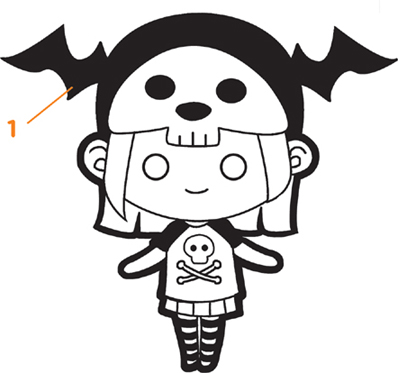
1. Add pointed tips to the underside of bat wings.
Gray isn’t usually used for Kawaii characters, because it’s not so buoyant. But it works well for Goths, in combination with other colors, such as black, red, lavender, pink, pale green, yellow, and purple.
Because Goths are such a popular part of Kawaii, they make an essential addition to our cast of hooded characters. These mixed-genre anthros are particularly entertaining—and popular with readers.
Combine several of the strongest visual elements from Goth and anthro to create an effective, mixed genre. For Goth, any of the following make good choices: skulls, bones, wings, spikes, chains, stitched scars, and a scythe. For anthros, choose from this select group: bats, black cats, snakes, spiders, wolves, crows, rats, toads, owls, dragons, and scorpions.
Notice how the skull design is positioned as part of the hood—as if it were almost framed by it. Drawn in this way, the outline of the character’s head is uninterrupted by the shape of the skull. It remains a smooth and stylish line, which is pleasing to the eye.
You see all the gothic stuff, but you might also be wondering, “Where are all the anthro elements?” Well, the cat ears are it. This is a technique called selective emphasis, which means you choose one theme to override another. In this case, the gothic genre leads and the anthro theme trails behind. You could reverse it by replacing the hood skull with a black panther’s head with its own set of eyes, nose, and mouth, for example. That would switch the emphasis back to anthros.

Start with a symmetrical seated pose.

1. A weird, pointed swatch of hair gives your character a severe look
2. Use empty eyes, signifying “evil.”

1. Make the cat ears shoot off at a diagonal from the head.
1. Simplify the Kawaii skull, omitting the jaw entirely.

Certain colors complement black particularly well. These include red, yellow, pink, and purple; however, be careful using a dark purple right next to black. That may be hard to read, because they’re both dark.